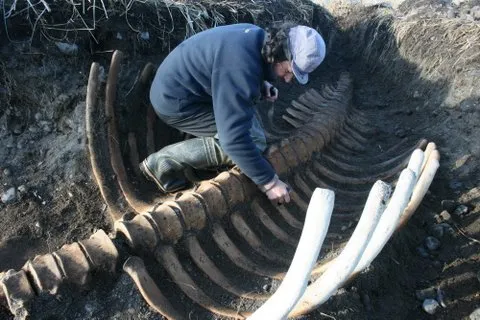Skeleton of a Massive Extinct Sea Cow Found on Siberian Island
Remains of the Steller’s sea cow shed light on one of the first animals that taught humans about extinction
/https://tf-cmsv2-smithsonianmag-media.s3.amazonaws.com/filer/d6/e6/d6e6580e-21c7-49ac-9a6a-343abebffb75/sea_cow-1.jpg)
By most standards, sea cows—a mammalian order that includes both manatees and dugongs—are pretty dang large. Also known whimsically as "sirenians," these related marine mammals can grow to be over 10 feet long, and weigh thousands of pounds. But in the 1700s, a sea cow existed whose bulk dwarfed even these gargantuan ocean-dwellers: the Steller's sea cow.
From the time it was first sighted in 1741, scientists had only about a quarter-century to classify this impressive beast. The Steller's sea cow would soon go extinct, with the last sighting happening in 1768. But earlier this month, Siberian researchers uncovered a nearly intact skeleton—a rare find that will help scientists better understand one of the animals that first taught humans about extinction, reports Vittoria Traverso at Atlas Obscura.
According to a press release from the Commander Islands Nature and Biosphere Reserve, researcher Marina Shitova was surveying the coast of one of the islands in the Bering Sea off the Kamchatka Peninsula when she noticed rib bones sticking out of the shoreline. After spending hours unearthing the skeleton, her team realized that it belonged to a sea cow that was an estimated 18 feet long. Prior to this find, the last full skeleton of a Steller’s sea cow was found on the same island in 1987 and ended up at the Aleutian Museum of Natural History in Nikolskoye, Traverso reports.
While the skull was missing, the researchers recovered 45 spinal bones, 27 ribs, the left shoulder blade as well as other shoulder bones and parts of the forearm and wrist. They then marked each of the bones so the skeleton could later be reassembled, and individually wrapped each bone to prevent damage in transport. The plan is to clean and reassemble the skeleton for display at the Commander Island visitor’s center.

Jacob Mikanowski at The Atlantic reports that the Steller’s sea cow was one of the last animals from the Pleistocene Epoch—the 2 million-year-long on-again off-again Ice Age that ended about 11,000 years ago—to disappear from Earth. At one point the species, Hydrodamalis gigas, was found all over the Pacific, from Japan all the way to the Mexico’s Baja Peninsula. But by the 18th century, only a small population was relegated to the remote Commander Islands.
In 1741, an expediton by Danish explorer Vitus Bering charted the waters between Kamchatka and Alaska. But on the return voyage, his two ships got separated, and one ran aground on one of the Commander Islands. Aboard that ship was German naturalist Georg Steller. While the captain died, the ship was destroyed and his fellow sailors suffered from scurvy, Steller kept healthy by munching on herbs that contained vitamin C.
That allowed him to explore the island, where he was surprised to discover the vast sea cows lolling in the chilly ocean waters.
Steller’s description paints a picture of gentle, socialable giants with the largest creatures reaching 30 feet in length. In fact, when his companions harpooned one of the cows for food, Steller witnessed the other animals making a circle around their comrade for denfense.
Mikanowski reports that, like many naturalists of his day, Steller thought the supply of sea cows was endless and believed the meat of the animals could support a fur-hunting post in the islands. That was not the case. In just 27 years, fur-hunters gobbled up all the remaining sea cows. Some ecologists argue that the over-hunting of sea otters also contributed to the end of the cows: The otters eat sea urchins, which destroy the kelp forests that the sea cows ate almost exclusively.
The disappearance of the Steller’s sea cow, along with other species like the dodo, helped convinced scientists by the early 19th century that plants and animals were not inexhaustible—and that extinction was a real phenomenon that could be hastened by human activity. In today's rapidly changing, human-dominated world, that understanding could not be more relevant.